There’s often some confusion about which American Airlines wide body jets have which business class seats. In this post, I’d like to provide a rundown of which seats you should expect to find in business class on various long haul flights. I figure this is an especially good time to look at this, given that American has just introduced an all-new business class seat.
Note that this is separate from the seats you’ll find in premium cabins on narrow body domestic flights, as those are very different different…
In this post:
American’s four business class seats
American has four different kinds of business class seats on its wide body aircraft, with the fleet comprised of Boeing 777s and Boeing 787s. The good news is that all American wide body jets feature fully flat beds and direct aisle access from all business class seats. Nonetheless, people have different preferences, and not all seats are created equal.
I actually think American’s long haul business class hard product is an advantage that American has, in terms of consistency:
- United Polaris business class is now available on most long haul aircraft, though the catch is that United has some 777s with eight seats per row in business class (used primarily for domestic flights), and also has some 757s that are used for long haul flights, including across the Atlantic
- Delta One business class lags the competition in terms of consistency of long haul product; specifically, I think Delta’s 767 business class is inferior to the business class products offered by American and United
So with the above out of the way, let’s take a look at American’s four types of business class seats, from most common to least common. Then in the next section, I’ll cover on which planes you’ll find which seats.
Collins Aerospace Super Diamond seat
The Collins Aerospace Super Diamond product is American’s most common business class seat. This is a reverse herringbone product in a 1-2-1 configuration, with all seats facing forward. It’s also the same seat that you’ll find on many airlines nowadays.
Aside from American’s brand new business class (which is least widely available), I’d say that this is the product that’s most popular with passengers. There’s not much variance in quality between seats, the seats are still quite modern, and tech is good. The only catch is that I find the footwell in this product to be quite small, as is common in many modern business class seats.
See my review of American’s Collins Aerospace Super Diamond seat.
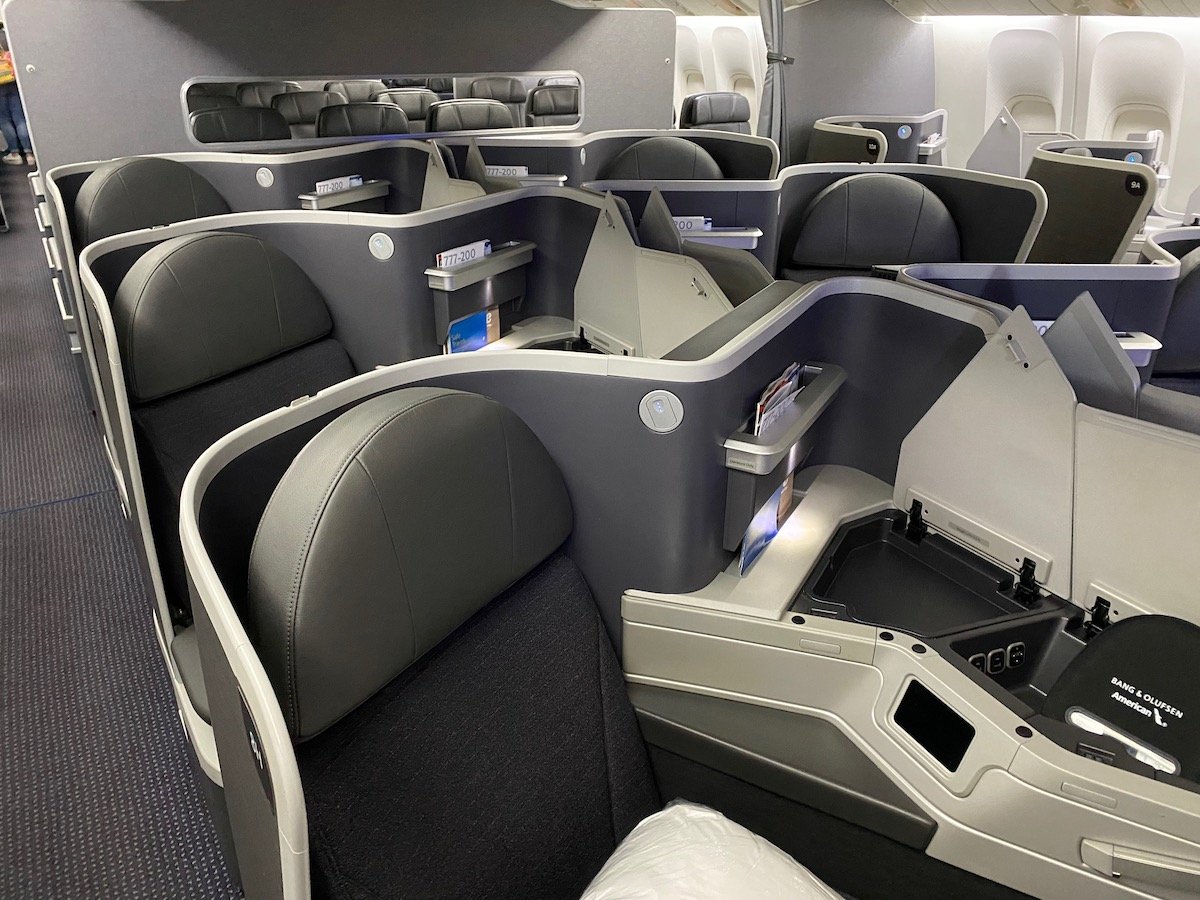
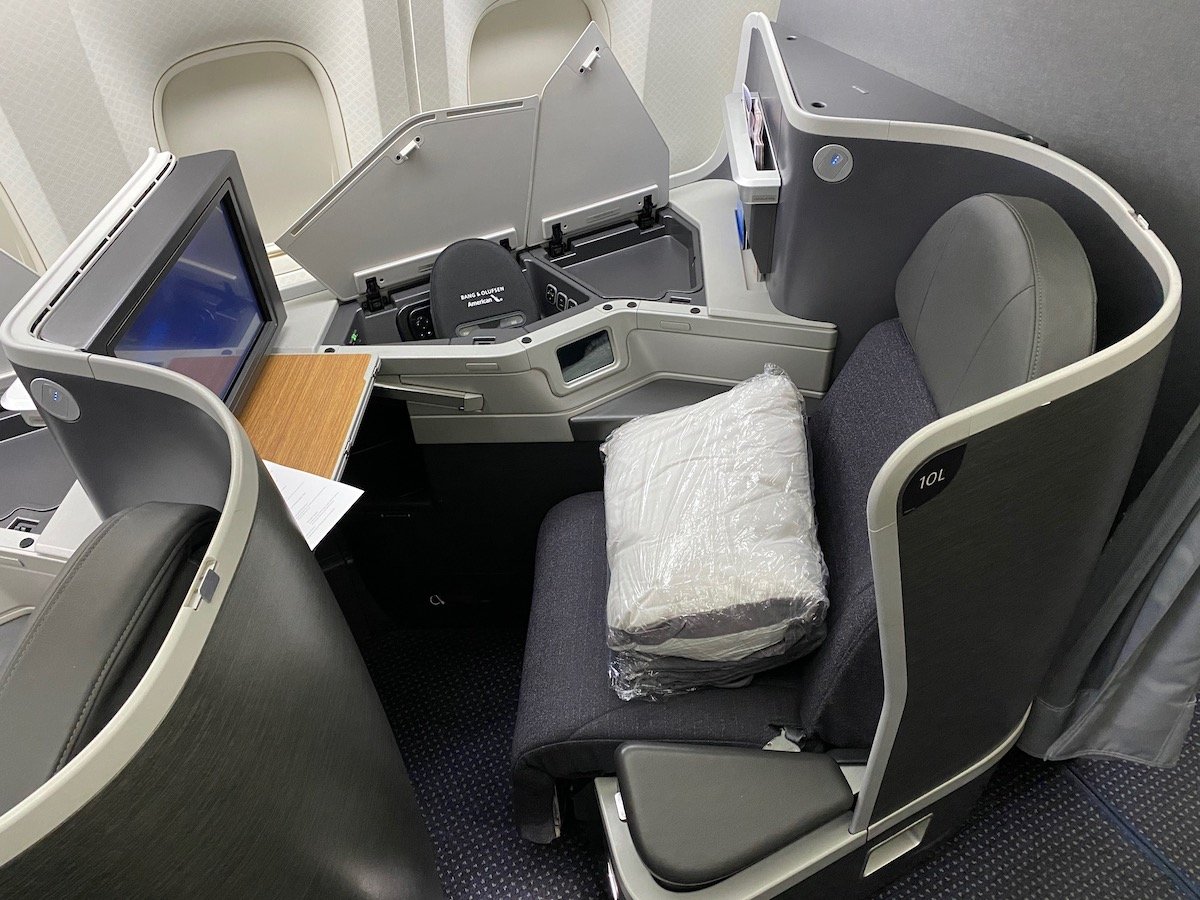
Safran Concept D seat
The Safran Concept D seat is American’s next most common business class seat. This is a staggered product in a 1-2-1 configuration, with seats alternating between being forward and rear facing. You won’t find these seats on any other airlines.
Many people don’t like these seats due to the lack of storage, plus there’s an issue whereby these seats “shake,” due to how they’re paired. Furthermore, these are some of American’s older business class cabins, so many of them have some wear and tear. However, I quite like that these seats have ottomans rather than footwells, so it’s quite comfortable in bed mode.
See my review of American’s Safran Concept D seat.
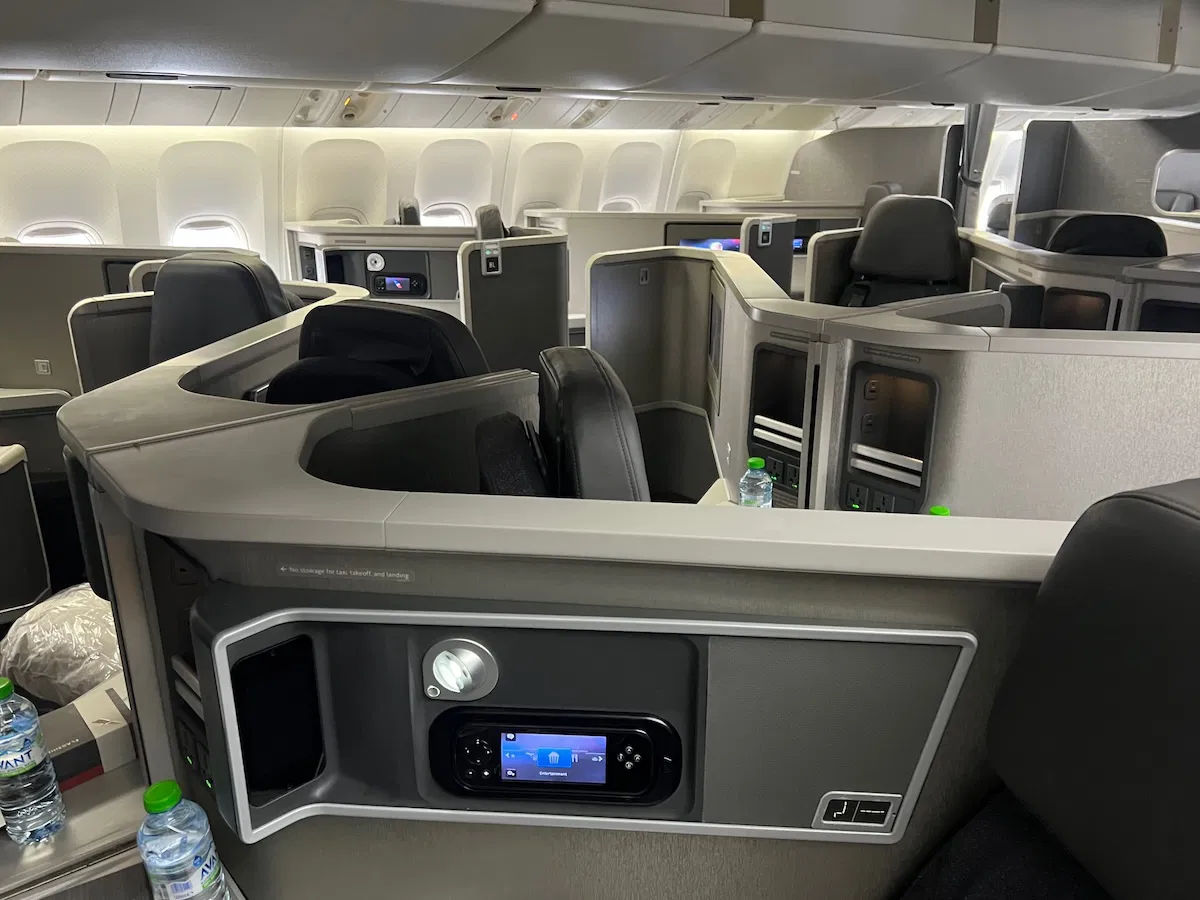
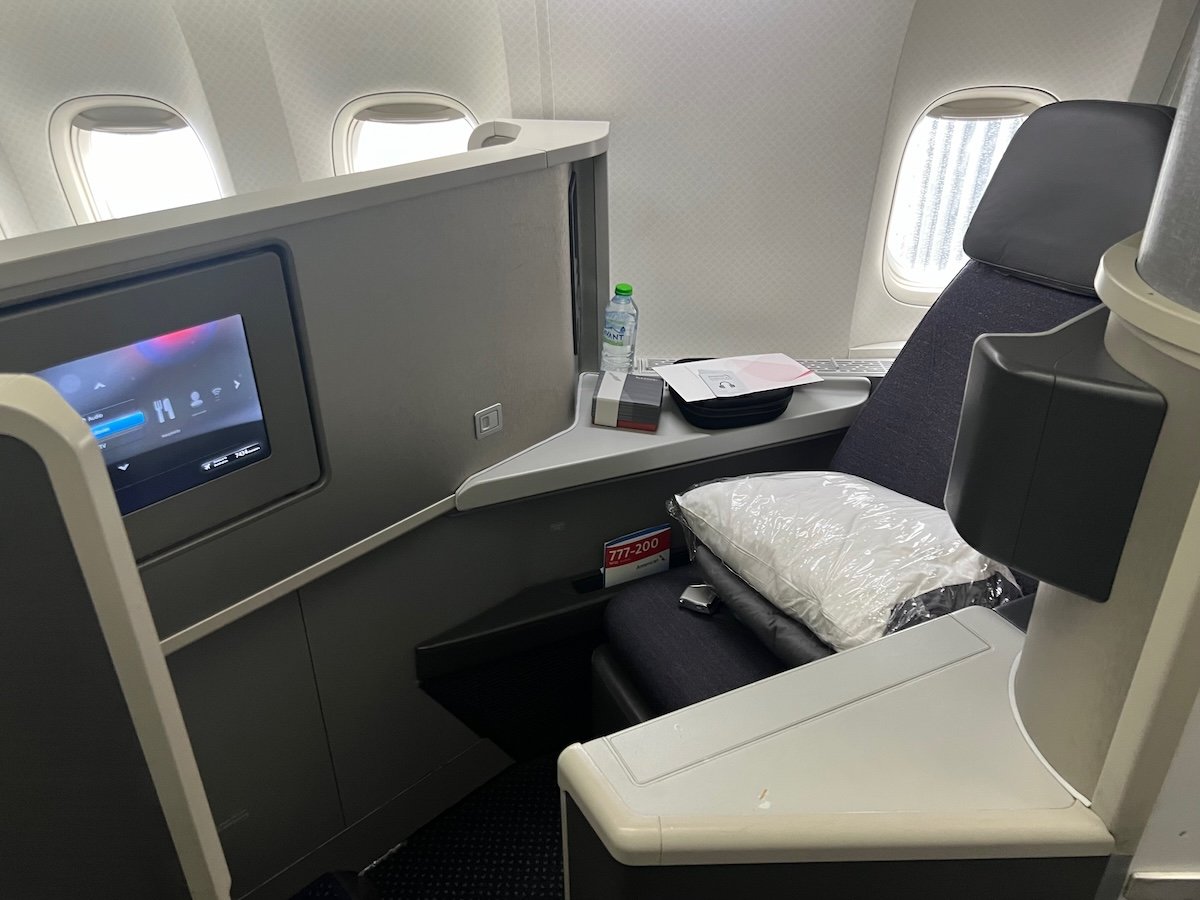
Safran Cirrus seat
The Safran Cirrus seat is American’s third most common type of business class seat. This is a reverse herringbone product in a 1-2-1 configuration, with all seats facing forward.
Personally I think the Collins Aerospace Super Diamond seat is just a bit more “evolved” than the Safran Cirrus seat, but many people like this product as well. Note that within the next couple of years, you’ll no longer find this seat on any American plane, so it’s slowly on the way out…
See my review of American’s Safran Cirrus seat.
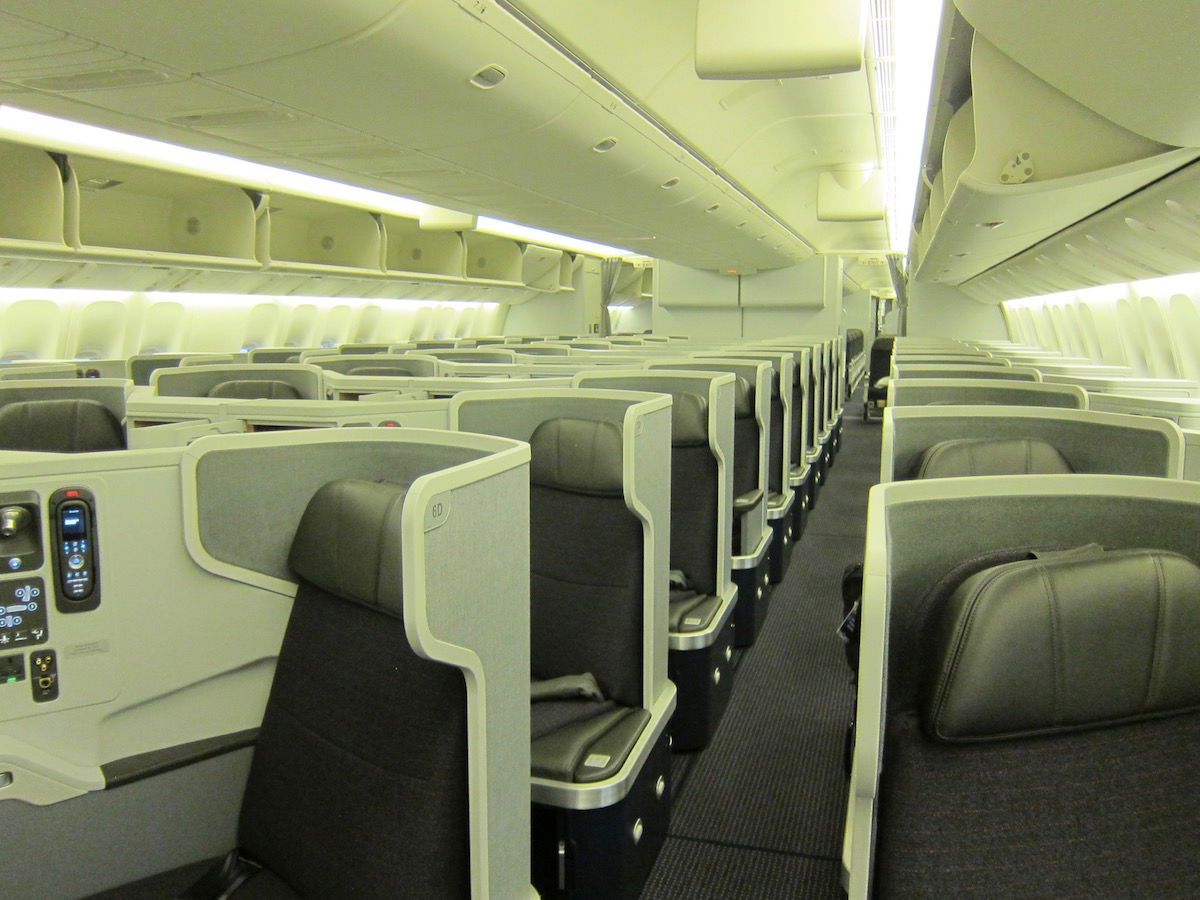
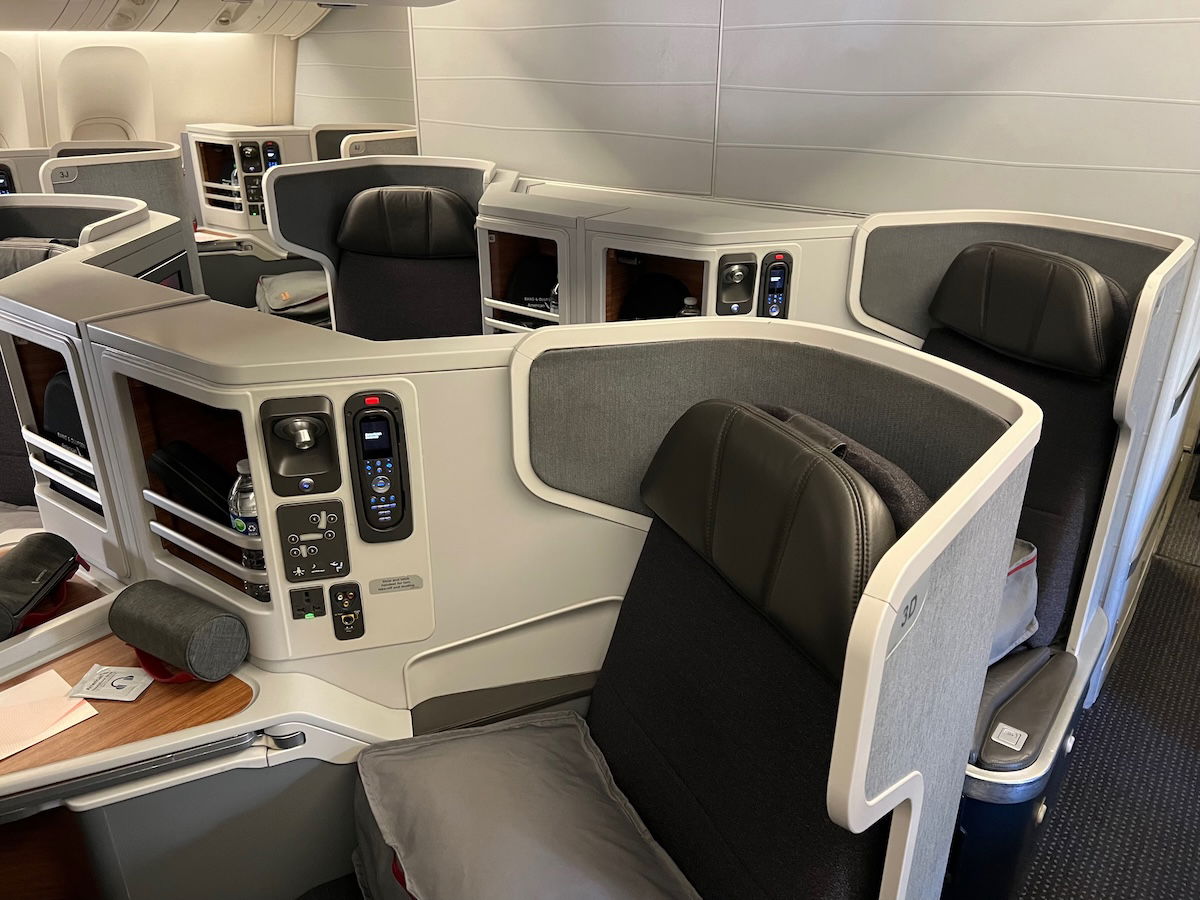
Adient Ascent seat
The Adient Ascent seat is American’s brand new business class seat. This is a reverse herringbone product in a 1-2-1 configuration, with all seats facing forward.
This seat is significantly upgraded over American’s previous reverse herringbone seats, with each seat having a door, and greatly upgraded tech. This includes bluetooth audio, upgraded Visasat Wi-Fi, and lots of charging options, with USB-A, USB-C, AC, and wireless charging.
See my review of American’s Adient Ascent seat.
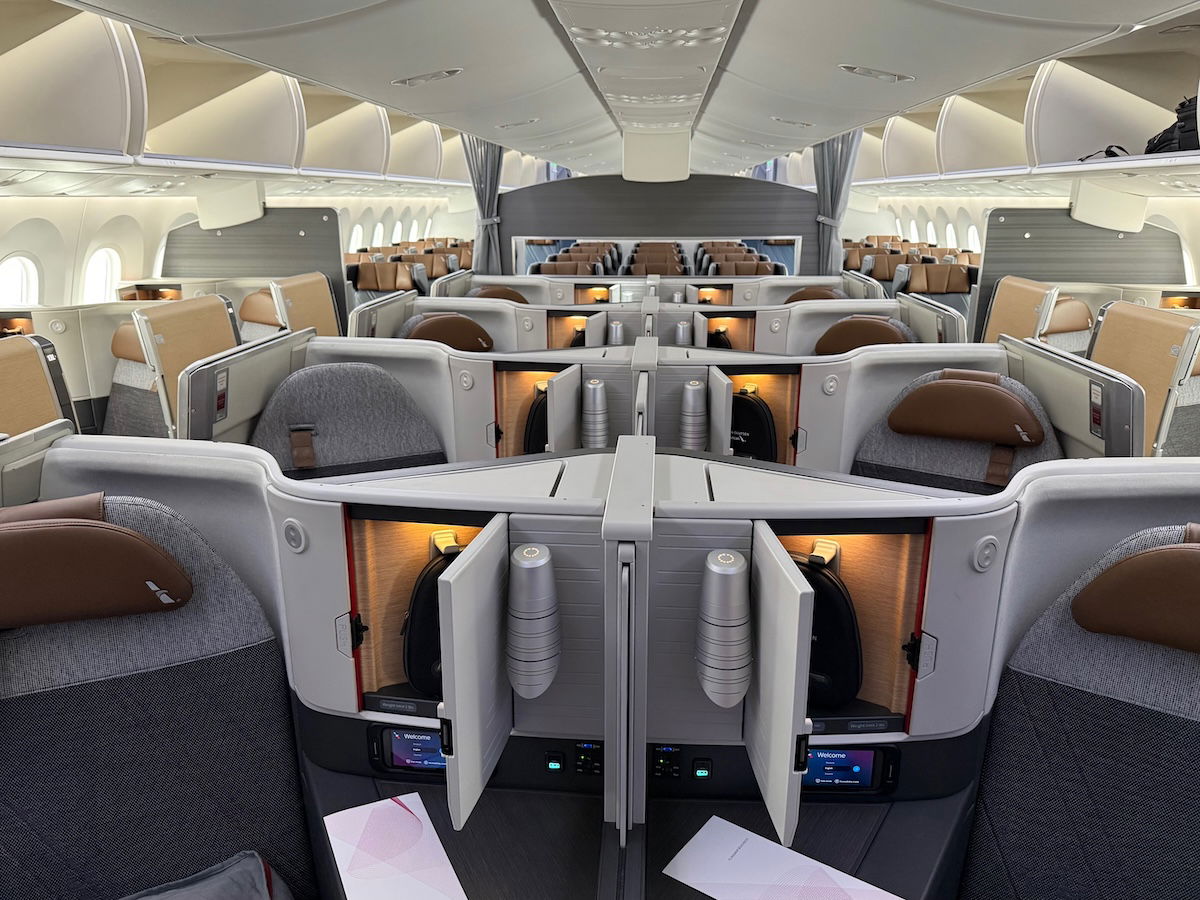
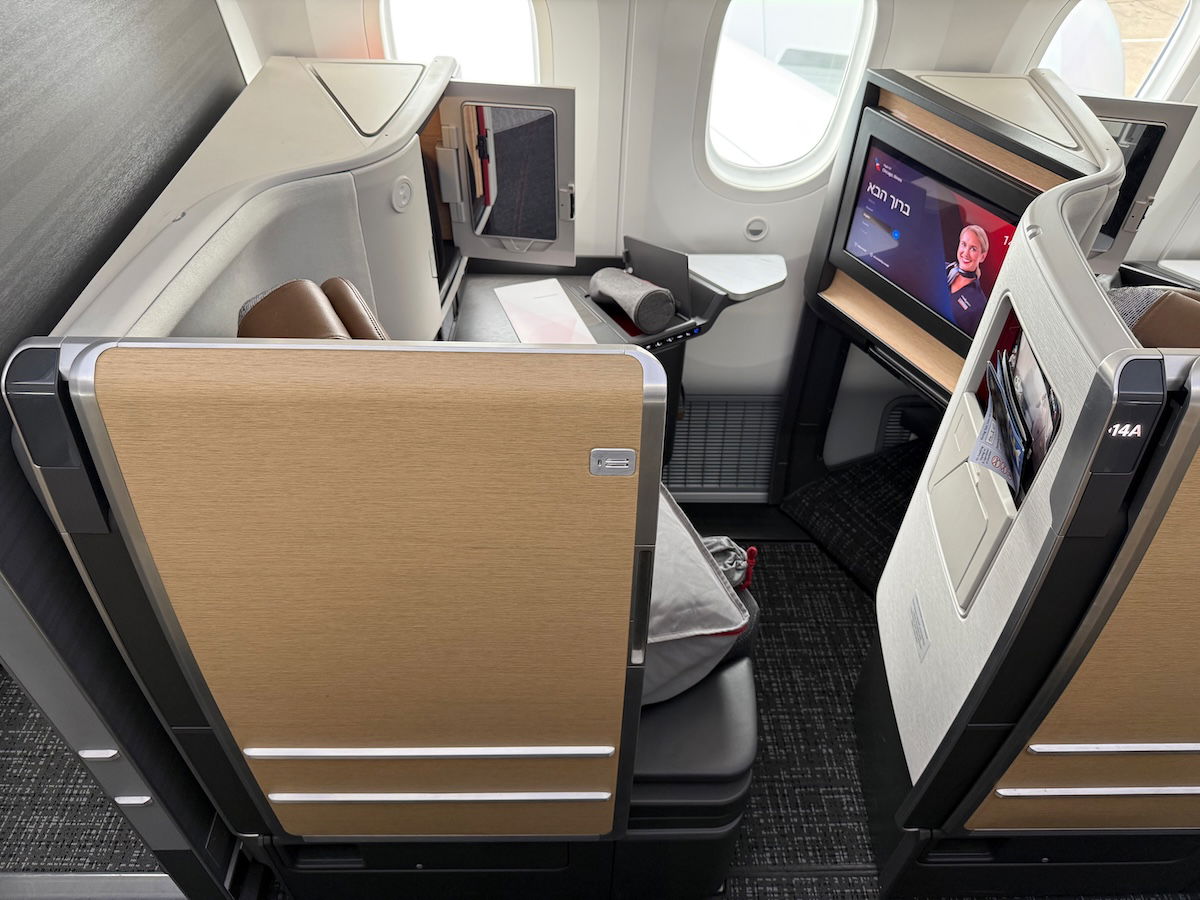
American’s business class seats by aircraft
While the above covers American’s four types of long haul business class seats, let’s talk about which seats you’ll find on which aircraft. Specifically, American flies four long haul aircraft variants, all from Boeing — the 777-200ER, the 777-300ER, the 787-8, and the 787-9. One of those jets has only one type of business class seat, while three of the jets have two kinds of business class seats.
American’s Boeing 777-200ER business class seat
American has 47 Boeing 777-200ERs in its fleet, each with 37 business class seats. Of those jets, 28 have the Collins Aerospace Super Diamond seats, while 19 have the Safran Concept D seats. As you can tell, the fleet is split about 60% and 40%.
Since the number of seats is identical, American swaps these planes between routes interchangeably, so there’s no way to know at the time of booking which product you’ll get. By default, American will display the Super Diamond seat map (since those planes are more common). Then within a few days of departure, American starts to firm up aircraft assignments, and adjusts seat maps accordingly.
The way to spot the difference on the seat map is based on whether seats in alternating rows have a little “V” cutout at the top. The seats with those cutouts are rear facing seats. So if the seat map has the cutout (shown with the 787-8 seat map a couple of sections down), it represents the Safran Concept D configuration, while if it doesn’t, it represents the Collins Aerospace Super Diamond configuration.
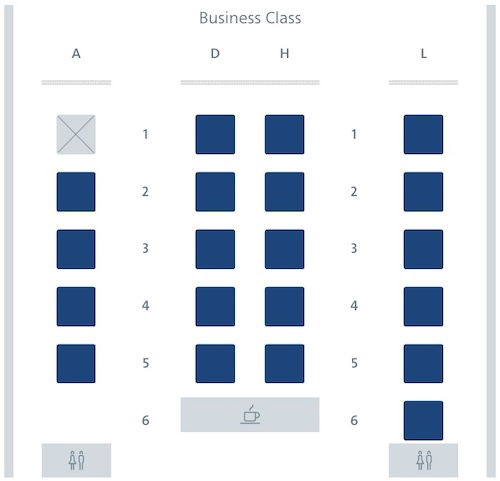
American has no plans to reconfigure existing 777-200ERs with the new business class.
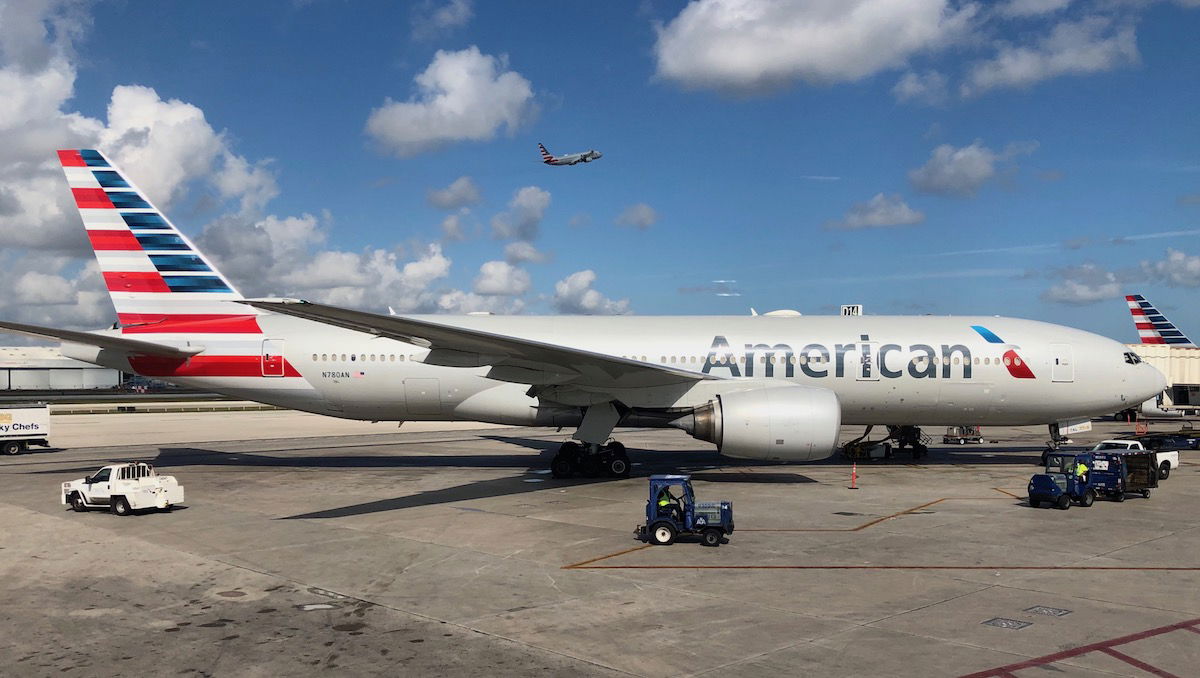
American’s Boeing 777-300ER business class seat
American has 20 Boeing 777-300ERs in its fleet, each with 52 business class seats. These planes all feature the Safran Cirrus product, so you know exactly what you’re going to get.
Note that American plans to reconfigure its 777-300ERs with the new business class, and it’s expected that this work could start around late 2025. Once these planes are reconfigured, we’ll also see first class eliminated.
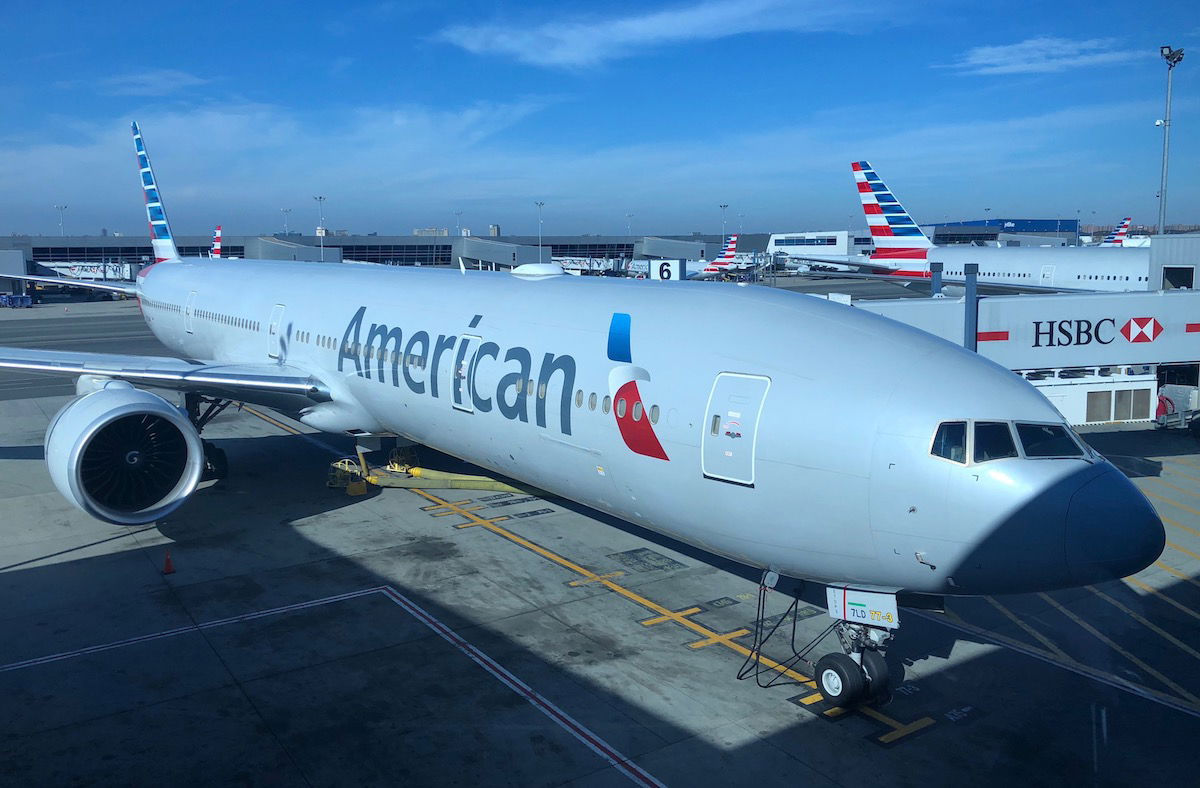
American’s Boeing 787-8 business class seat
American has 38 Boeing 787-8s in its fleet, each with 20 business class seats. Of those jets, 20 have the Safran Concept D seats, while 18 have the Collins Aerospace Super Diamond seats. As you can tell, the fleet is split pretty evenly, with the slight edge going to the Safran Concept D seats.
Since the number of seats is identical, American swaps these planes between routes interchangeably, so there’s no way to know at the time of booking which product you’ll get. By default, American will display the Safran Concept D seat map (since those planes are more common). Then within a few days of departure, American starts to firm up aircraft assignments, and adjusts seat maps accordingly.
The way to spot the difference on the seat map is based on whether seats in alternating rows have a little “V” cutout at the top. The seats with those cutouts are rear facing seats. So if the seat map has the cutout, it represents the Safran Concept D configuration, while if it doesn’t (shown with the 777-200ER seat map a couple of sections up), it represents the Collins Aerospace Super Diamond configuration.
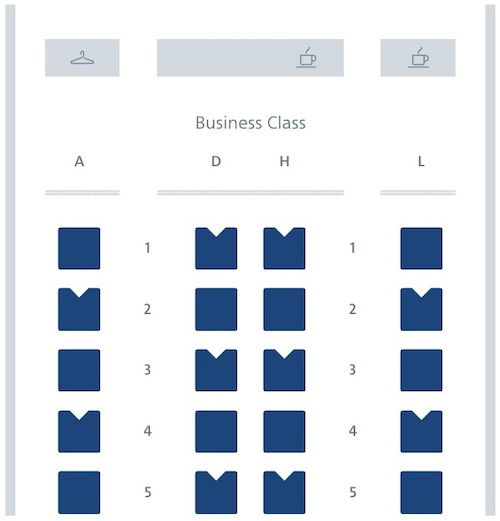
American has no plans to reconfigure existing 787-8s with the new business class.
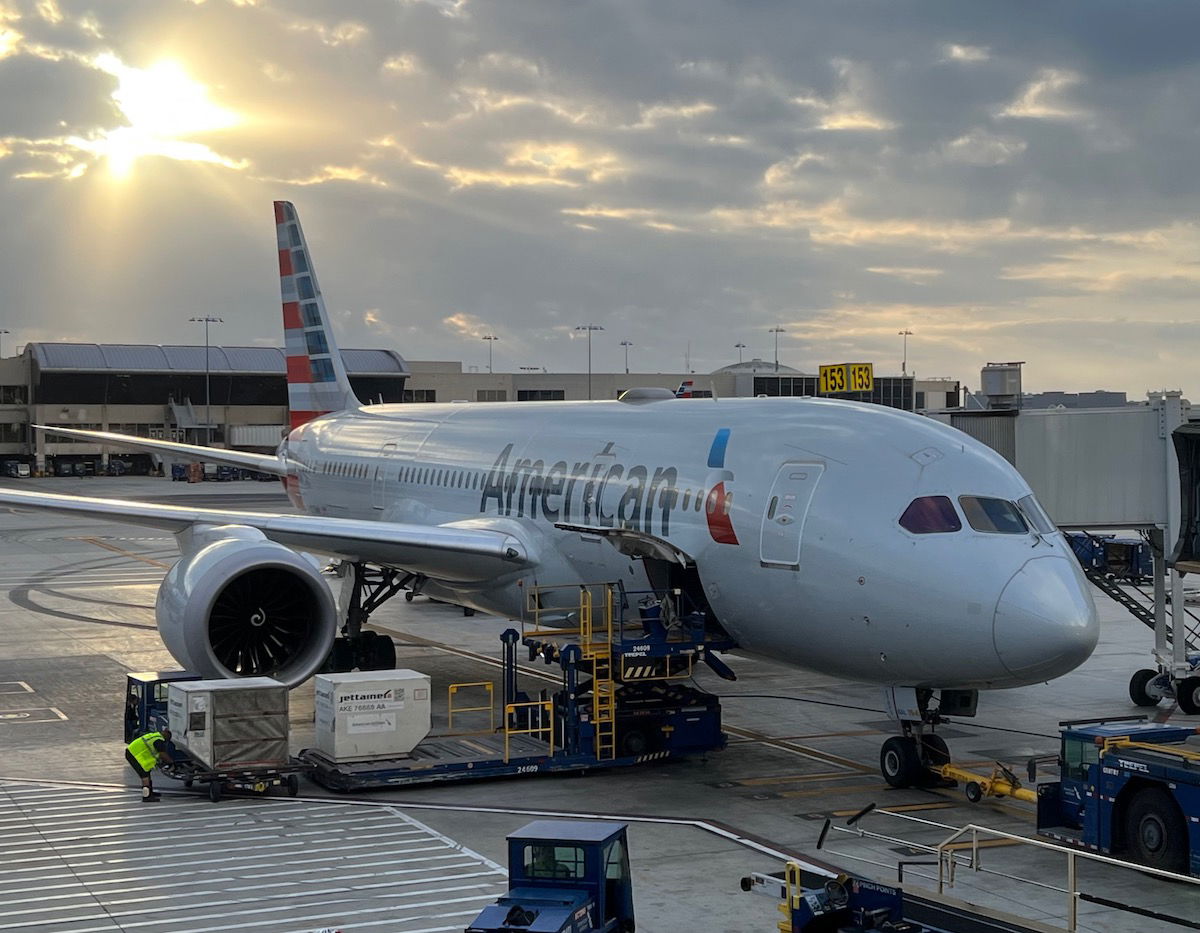
American’s Boeing 787-9 business class seat
American has 27 Boeing 787-9s in its fleet, and these have two very different layouts, and you know at the time of booking which product you’ll get.
22 of these 787-9s (designated on American’s website as “789-Boeing 787”) feature 30 business class seats. These planes feature the Collins Aerospace Super Diamond product, the same as on some 787-8s, so you know exactly what you’re going to get.
American has also introduced a new business class product, which debuted on the 787-9. Specifically, American has five 787-9s (designated on American’s website as “78P-Boeing 787”) featuring 51 business class seats. These planes feature the new Adient Ascent product, which is without a doubt American’s best business class seat.
American has a total of 30 of these new 787-9s on order, so you can expect another 25 to join the fleet in the coming years.
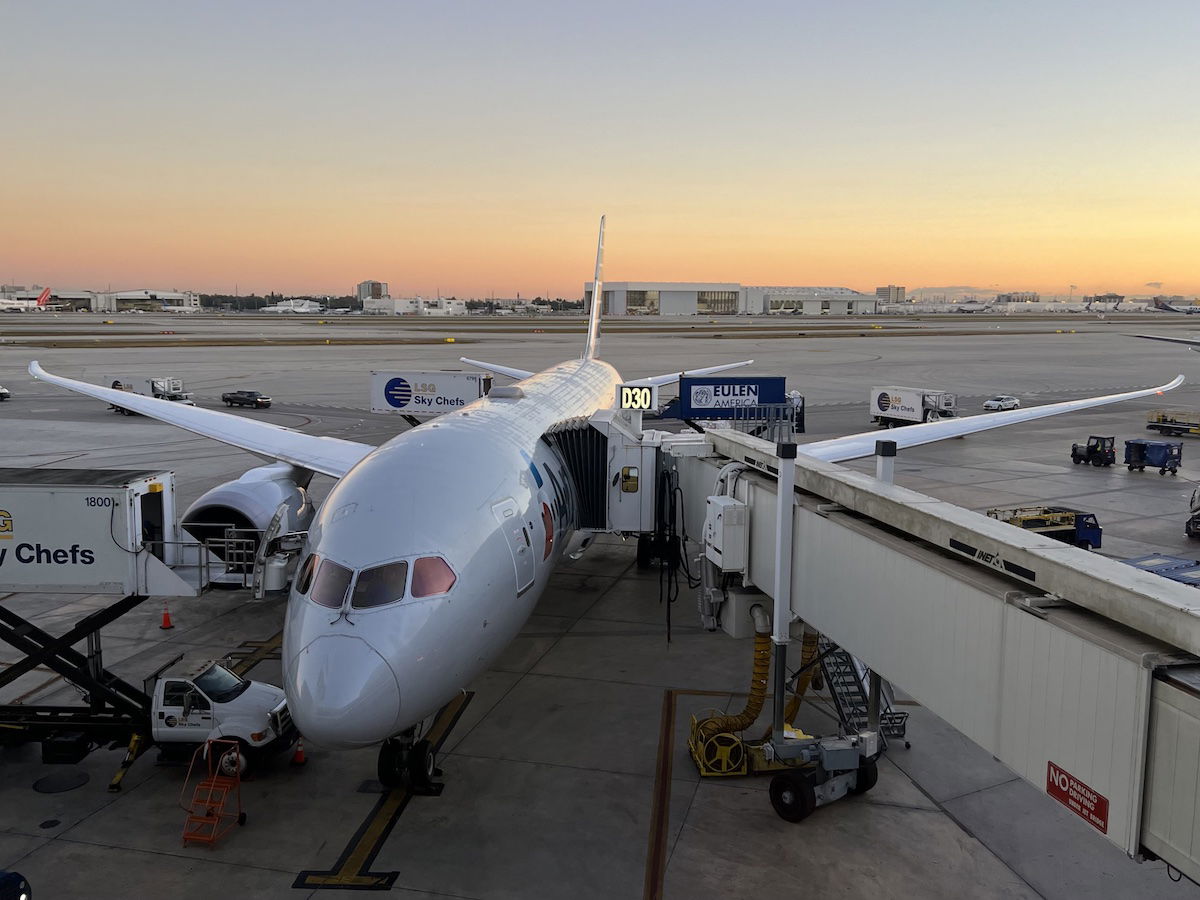
Bottom line
American has four different long haul business class seats, and for the average traveler, it can be hard to keep track of which seat you’ll find on which aircraft. Hopefully the above is a useful rundown.
To summarize, all 777-300ERs have Safran Cirrus seats, 777-200ERs and 787-8s have a mix of Safran Concept D seats and Collins Aerospace Super Diamond seats, and 787-9s have a mix of Collins Aerospace Super Diamond seats and Adient Ascent seats.
For 777-200ERs and 787-8s, you won’t know until a few days before departure which type of product is scheduled for your flight. Meanwhile for 787-9s, American schedules the type of product you can expect more reliably, since the two versions of the plane have very different layouts.
The good news is that all four of these seats are pretty great, at least in my opinion. Obviously the Adient Ascent seat is the best, but the other three are competitive as well.
What do you make of American’s long haul business class cabins?
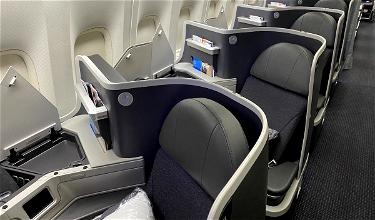

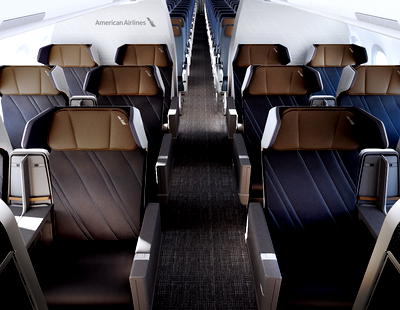
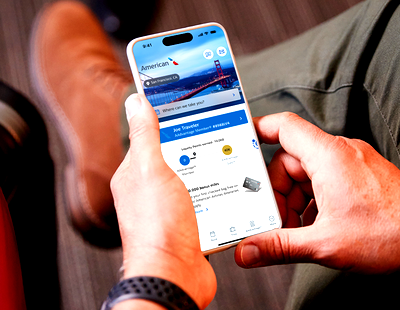
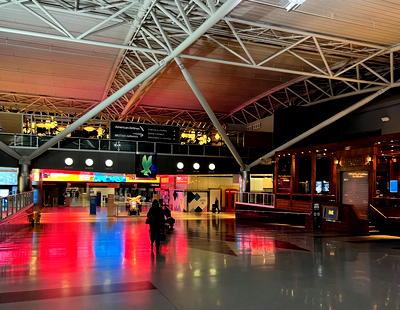
@TimDunn. American’s first 77-2 delivery of nose #7AA was in 1999. It flew DFW NRT exclusively & then the fleet expanded to JFK & MIA.
The 77-2’s are going to be refurbished and fly another ten years as they are built like tanks.
That’s from a legitimate HDQ source.
The Airbus XLR & re-furbished 77-3’s come on-line the end of fourth quarter 2025 most likely December.
Please stop stating personal opinions as company facts. Delta or otherwise.
let's see if AA or UA refurbish and keep their 777-200/ERs but they will be the laughingstock of the global airline industry. the 772 is built like a tank but so was the DC9.
The 772 is up there with the most fuel INEFFICIENT airplane types in the US widebody fleet. Even though fuel prices are relatively low right now and the current energy policy is to keep fossil fuels flowing and energy prices...
let's see if AA or UA refurbish and keep their 777-200/ERs but they will be the laughingstock of the global airline industry. the 772 is built like a tank but so was the DC9.
The 772 is up there with the most fuel INEFFICIENT airplane types in the US widebody fleet. Even though fuel prices are relatively low right now and the current energy policy is to keep fossil fuels flowing and energy prices down, that could quickly change.
and it will still be old. airplanes run into cycle and total flight limits. I do not know where AA or UA's 772s fall but the issue is not just about durability or flight time. Maintenance gets more and more costly.
I would be surprised if AA or UA refurbish their entire fleets of 772/ERs because if they do, they would need to keep them into the 2030s to justify the expense.
for AA's network the 787-10 would be a very cost-efficient replacement.
By 2035 Delta will have doors on all of their economy seats and they will be bookable to most TATL destinations for 200,000 Sky Miles - one way.
I’d sure like to see AA reconfigure the 777-200s that currently feature the concept D seats with the seats pulled out of the -300s when they get the new biz class.
-

Tim Dunn Diamond
July 31, 2025, 11:28 am
Read more
Helpful
-

Eskimo Guest
July 31, 2025, 12:10 pm
Read more
Helpful
-

ZEPHYR Guest
July 31, 2025, 12:22 pm
Helpful
-

Tim Dunn Diamond
July 31, 2025, 12:40 pm
Read more
Helpful
-

Derek Guest
July 31, 2025, 1:06 pm
Read more
Helpful
-

Tim Dunn Diamond
July 31, 2025, 1:22 pm
Read more
Helpful
-

ZEPHYR Guest
July 31, 2025, 1:46 pm
Read more
Helpful
-

rebel Member
July 31, 2025, 2:18 pm
Read more
Helpful
-

ZEPHYR Guest
July 31, 2025, 2:42 pm
Read more
Helpful
-

rebel Member
July 31, 2025, 3:38 pm
Read more
Helpful
-

ZEPHYR Guest
July 31, 2025, 4:20 pm
Read more
Helpful
-

rebel Member
July 31, 2025, 4:25 pm
Helpful
-

ZEPHYR Guest
July 31, 2025, 4:41 pm
Read more
Helpful
-

rebel Member
July 31, 2025, 4:59 pm
Read more
Helpful
-

ZEPHYR Guest
July 31, 2025, 1:51 pm
Helpful
-

ZEPHYR Guest
July 31, 2025, 1:57 pm
Helpful
-

Eskimo Guest
July 31, 2025, 2:20 pm
Read more
Helpful
-

Tim Dunn Diamond
July 31, 2025, 2:50 pm
Read more
Helpful
-

rebel Member
July 31, 2025, 3:48 pm
Helpful
-

Tim Dunn Diamond
July 31, 2025, 5:09 pm
Read more
Helpful
-

rebel Member
July 31, 2025, 5:19 pm
Helpful
-

Tim Dunn Diamond
July 31, 2025, 5:25 pm
Read more
Helpful
-

rebel Member
July 31, 2025, 5:49 pm
Helpful
-

Tim Dunn Diamond
July 31, 2025, 6:16 pm
Helpful
-

rebel Member
July 31, 2025, 6:34 pm
Helpful
-

Tim Dunn Diamond
July 31, 2025, 6:47 pm
Read more
Helpful
25 more repliesthe 772s won't be reconfigured because AA is certain to replace them within 5 years, likely with the 787-10.
AA's 772s were almost entirely delivered during a 3 year period that encompasses 9/11 so those aircraft will start turning 30 years old pretty soon. Overhauls just aren't worth it at that age.
UA has an even larger fleet of 772s plus their fleet of 767s; unlike DL, UA has not started to get rid of...
the 772s won't be reconfigured because AA is certain to replace them within 5 years, likely with the 787-10.
AA's 772s were almost entirely delivered during a 3 year period that encompasses 9/11 so those aircraft will start turning 30 years old pretty soon. Overhauls just aren't worth it at that age.
UA has an even larger fleet of 772s plus their fleet of 767s; unlike DL, UA has not started to get rid of its 767 fleet.
DL already has 80 aircraft with Delta One Suites, which as much as some people want to argue otherwise, are and will be comparable to AA and UA's first generation suite product - other than the extra space in the first row of each cabin.
AA is likely to be in the second best position with new generation business class seats because it is ordering in small enough quantities to also get seat suppliers to build seats for retrofits; as much as some people love to talk bout the size of UA's massive widebody order, the downsize is that they tied up their orderbook for seats with new aircraft, leaving little to no room for retrofits.
If AA succeeds at upgrading its onboard service - which is happening - they will be in a stronger position with product than UA even with AA's smaller international network.
I want to argue otherwise, Tim.
Let's start with the fluff.
Out of the "DL already has 80 aircraft with Delta One Suites", did you convinced yourself to include the exLATAM planes there too.
UA didn't need to get red of their 767 is because their Polaris seats are actually consistent with their other planes. You get a proper 1-1-1 on UA rather than the greedy 1-2-1 on DL.
Delta still have over 60...
I want to argue otherwise, Tim.
Let's start with the fluff.
Out of the "DL already has 80 aircraft with Delta One Suites", did you convinced yourself to include the exLATAM planes there too.
UA didn't need to get red of their 767 is because their Polaris seats are actually consistent with their other planes. You get a proper 1-1-1 on UA rather than the greedy 1-2-1 on DL.
Delta still have over 60 767s flying and the -400, which is also as old as AA 772s would fly beyond 2030, maybe even 2035.
Those ex LATAM A350 are about 65% complete in their retrofit cycle, they will be completed before the end of this year.
The older A350 with 32 business class seats and 48 premium economy retrofit is planned to start Q2 2026
thank you, zephyr
the complete hypocrisy with eskimo and others' fixation with the ex-Latam 350s is that they are part of what is pushing the increase in the number of Delta One equipped aircraft.
...DL is supposed to receive 12 new 339s and 359s this year, all of which are equipped with D1 Suites, and also will add the 9 ex-Latam 350s so DL will add over 20 D1 Suite equipped aircraft this year.
thank you, zephyr
the complete hypocrisy with eskimo and others' fixation with the ex-Latam 350s is that they are part of what is pushing the increase in the number of Delta One equipped aircraft.
DL is supposed to receive 12 new 339s and 359s this year, all of which are equipped with D1 Suites, and also will add the 9 ex-Latam 350s so DL will add over 20 D1 Suite equipped aircraft this year.
It is no wonder that little people like Eskimo try so hard to minimize what DL is accomplishing.
and DL's 767 fleet is just 7 aircraft larger than UA's but UA has 40 757s that fly routes to the UK and continental Europe which DL 757s no longer do.
It is complete hypocrisy to act like UA's 757s aren't much worse than DL's 763s when all of DL's 767 fleet has direct aisle in business class but none of UA's 757s do - let alone the 737s that UA flies across the Atlantic.
It is absolutely fair and accurate to note that UA will be the last of the big 3 to have their fleet equipped with new generation business class seats while DL is now on the verge of rolling out its 2nd generation Delta One Suite and AA will convert a higher percentage of its fleet faster than UA will.
UA's 757s and 737s largely serve smaller, incremental destinations that DL and AA simply don't serve because they don't have the right aircraft. With a few exceptions, anywhere DL or AA flies a widebody, UA is matching.
I'd rather have the option of more direct TATL destinations with some of the smaller ones served by inferior equipment than fewer options, even if I personally would rather add a connection to avoid the inferior equipment....
UA's 757s and 737s largely serve smaller, incremental destinations that DL and AA simply don't serve because they don't have the right aircraft. With a few exceptions, anywhere DL or AA flies a widebody, UA is matching.
I'd rather have the option of more direct TATL destinations with some of the smaller ones served by inferior equipment than fewer options, even if I personally would rather add a connection to avoid the inferior equipment. More options is better for the entire airline's customer base.
No one has a problem w/ anyone having a choice.
The problem is with people that hypocritically argue that "their brand" is better because of some cherrypicked data point that doesn't stand up to scrutiny.
It doesn't matter if UA uses narrowbodies to Europe on routes that other carriers don't serve.
There were several months this year when DL had no 763s flying across the Atlantic.
The 763 for DL is a flex summer...
No one has a problem w/ anyone having a choice.
The problem is with people that hypocritically argue that "their brand" is better because of some cherrypicked data point that doesn't stand up to scrutiny.
It doesn't matter if UA uses narrowbodies to Europe on routes that other carriers don't serve.
There were several months this year when DL had no 763s flying across the Atlantic.
The 763 for DL is a flex summer capacity TATL aircraft until it is retired from international service. It is also used to S. America in their summer.
A growing percentage of the fleet is used on domestic flights - where it competes also with UA's 777As which do not have direct aisle first or business class as well as with the 757s.
And the point is still that AA retired its widebodies during covid, DL did some during covid and has more than replaced what was retired and is taking delivery of more new widebodies even while also retiring more 767s every year. UA, in contrast did not and is not retiring any widebodies.
AA and DL by virtue of retiring aircraft already have and will have a higher percentage of new generation aircraft w/ new generation cabins than UA.
and older aircraft aren't just about business class. It is about the cost and reliability of those older aircraft.
Boeing will eventually get its act together and deliver 787s at the rate that UA has been expecting for years - and UA will be forced to retire scores of widebodies over a very short period of time - quite a contrast to the massive growth that so many think UA will be able to engage in.
All airlines operate a little differently.
The subset of people that selectively pick data to argue against someone else is not only tiresome but it is just plain dishonest. As long as there are people like Eskimo, I will have a reason to come behind and clean up.
@Eskimo
The affirmed Polaris seats in its current form will be a huge 'Thorn in the flesh' for United between the next 2 to 10 years to come.
United rolled out the Polaris seats in about the same time Delta got the Delta One suites (2017). The retrofit programme was initially slow if not almost nonexistent, it didn't pick up to speed till end of 2019 to 2023 only concluding in 2024, over 7...
@Eskimo
The affirmed Polaris seats in its current form will be a huge 'Thorn in the flesh' for United between the next 2 to 10 years to come.
United rolled out the Polaris seats in about the same time Delta got the Delta One suites (2017). The retrofit programme was initially slow if not almost nonexistent, it didn't pick up to speed till end of 2019 to 2023 only concluding in 2024, over 7 years to retrofit the entire fleet. Consistency is great, but it gets to a point it becomes a massive issue.
UA placed massive orders for 150 B787 between 2021 to 2023. The initial plan I believe would have been for this jets to replace the flock of older B763 and B772, but with Boeing recent issues, that have become a difficult situation for them. The cabin products they ordered would have been geared towards this new aircraft and no retrofit plan was considered (currently) for newer aircraft like the B773, B788, B789, B781.
Because of the initial slow speed of retrofit, they're in a position in which this jets are still not up to the usual 8 to 10 year mark before retrofit. It won't be economical for them to take out seats that were just installed 2-5 years ago.
"UA didn't need to get red of their 767 is because their Polaris seats are actually consistent with their other planes"
I will say that UA didn't need to have retrofitted all those B763, they would have rushed to retire them a bit faster, used the B763 retrofit slots for the B787.
I will want to see what all these UA fans and executives who horn soo much on consistency do come 2026 go 2035. The current Polaris seats will fly past the mid point of the 2030's
Zephyr says, "United rolled out the Polaris seats in about the same time Delta got the Delta One suites (2017). The retrofit programme was initially slow if not almost nonexistent, it didn't pick up to speed till end of 2019 to 2023 only concluding in 2024, over 7 years to retrofit the entire fleet.
Because of the initial slow speed of retrofit, they're in a position in which this jets are still not up to...
Zephyr says, "United rolled out the Polaris seats in about the same time Delta got the Delta One suites (2017). The retrofit programme was initially slow if not almost nonexistent, it didn't pick up to speed till end of 2019 to 2023 only concluding in 2024, over 7 years to retrofit the entire fleet.
Because of the initial slow speed of retrofit, they're in a position in which this jets are still not up to the usual 8 to 10 year mark before retrofit."
So United was slow? Interesting.
UA: 204 wide bodies with Polaris in 7 years = 30/year, 91% of wide bodies
DL: 80 wide bodies with Delta One in 8 years = 10/year, 47% of wide bodies
Delta didn't take 8yrs to retrofit their aircrafts.
Most are new deliveries, and only the B772, B763 and B764 were retrofitted and we're all completed earlier.
UA didn't retrofit 204 widebodies in 7yrs, a good number were new builds. All B773, B781, most of B789 were new builds.
Most of you on here seem to only pick on a point not looking at the sentence in complete term.
UA retrofit started out initial slow...
Delta didn't take 8yrs to retrofit their aircrafts.
Most are new deliveries, and only the B772, B763 and B764 were retrofitted and we're all completed earlier.
UA didn't retrofit 204 widebodies in 7yrs, a good number were new builds. All B773, B781, most of B789 were new builds.
Most of you on here seem to only pick on a point not looking at the sentence in complete term.
UA retrofit started out initial slow (less than 5 in 2017, about 15 in 2018, it only really kicked off in 2019 slowing down much in 2020 and 2021 and picking back up between 2022 to 2024)
Now I'm not saying most of the faults lie with United, Safran was initially very slow delivering the seats (the B773 EIS was delayed because of this issues
Zephyr say, "Delta didn't take 8yrs to retrofit their aircrafts."
A distinction without a difference. In the eight years since its introduction Delta offers D1 suites on less than 50% of its wide bodies. United did a much better of outfitting 100% of its international wide body fleet with Polaris, Premium Plus and Economy Plus in a shorter time and capturing the seemingly limitless international premium demand.
Zephyr said, "If I were the one making...
Zephyr say, "Delta didn't take 8yrs to retrofit their aircrafts."
A distinction without a difference. In the eight years since its introduction Delta offers D1 suites on less than 50% of its wide bodies. United did a much better of outfitting 100% of its international wide body fleet with Polaris, Premium Plus and Economy Plus in a shorter time and capturing the seemingly limitless international premium demand.
Zephyr said, "If I were the one making decisions for UA, I will would have stopped the Polaris retrofit in 2021/2022"
That would have been a huge mistake given the massive post-Covid international demand.
Derek said, "I'd rather have the option of more direct TATL destinations with some of the smaller ones served by inferior equipment than fewer options, even if I personally would rather add a connection to avoid the inferior equipment. More options is better for the entire airline's customer base."
Agreed. United matched the product to boom in international demand very well. United earned 50% more international revenue than Delta in the first half of 2025 even with EWR's issues.
Nice one @ Eskimo.
I normally don't comment much or drop a very long comment. Seems to have a load of time I have nothing important to do with.
That being said, I in no way look at Delta as the next best thing after slice bread. There's just a lot of misinformation and comments aimed at discrediting Delta because of the way Tim Dunn has very rigorously portrayed Delta.
I have in the...
Nice one @ Eskimo.
I normally don't comment much or drop a very long comment. Seems to have a load of time I have nothing important to do with.
That being said, I in no way look at Delta as the next best thing after slice bread. There's just a lot of misinformation and comments aimed at discrediting Delta because of the way Tim Dunn has very rigorously portrayed Delta.
I have in the past, gone at it with Tim Dunn probably trying to correct some of his factual errors.
Delta is a good enough airline, by North American Standards, they excel at more different criterias than any other north American carrier. But United is actually highly in pursuit of Delta in alot more ways
Quoting a United executive 'its better to be a close no 2 and be really good than to be no 1 with poor financial results'
Cash Flow (Op/Free)
Year DAL UAL
2019 8.4/4.2 6.9/1.2
2024 8.0/3.4 9.6/4.0
2025 4.2/2.0 5.7/3.3 (Q1&2)
@ rebel
You're not looking at all my statements in complete terms.
"Zephyr said, "If I were the one making decisions for UA, I will would have stopped the Polaris retrofit in 2021/2022"
That would have been a huge mistake given the massive post-Covid international demand."
Don't you think suspending retrofit would have been better for finances if there's huge demand post covid, instead of packing those jets for 3 to 4 weeks, have...
@ rebel
You're not looking at all my statements in complete terms.
"Zephyr said, "If I were the one making decisions for UA, I will would have stopped the Polaris retrofit in 2021/2022"
That would have been a huge mistake given the massive post-Covid international demand."
Don't you think suspending retrofit would have been better for finances if there's huge demand post covid, instead of packing those jets for 3 to 4 weeks, have them do some shorter distance flying and generate more revenue.
Meanwhile I provided a better alternative to stopping Polaris seats rollout, the B787s yet to be reconfigured will get suites instead. United simply was late to the suite game.
"Zephyr say, "Delta didn't take 8yrs to retrofit their aircrafts."
A distinction without a difference. In the eight years since its introduction Delta offers D1 suites on less than 50% of its wide bodies. United did a much better of outfitting 100% of its international wide body fleet with Polaris, Premium Plus and Economy Plus in a shorter time and capturing the seemingly limitless international premium demand."
I never made mention of total percentage of fleet spotting the new seats, I simply was talking about different approach taken.
DL retrofitted the B772 mainly because they were used on their longest flights, the A330CEO also have an aging cabin, but they didn't priotise grounding those jets for 3 to 5 weeks to change out the interiors during pick demand period post covid.
No other large carrier followed UA approach to retrofit, Qatar stopped their cabin retrofit in 2020 (only doing 3-5 more frames recently) BA stopped/slowed their retrofit between 2020 to 2022, ANA didn't complete "The Room" rollout because of covid.
Passengers barely pay enough premium to justify most carriers to have consistent cabins, don't expect the next generation of Polaris suites on all widebody fleet by 2035. Product consistency doesn't pay much UA won't waste billions retrofitting all the B773, B788, B789, B781 (which is close to 100 jets in total) $25m for each brings cost to $2.5billion.
It also interesting how you got your 50% and 100% respectively. DL B763 are now almost exclusively domestic routes which is a far better product than United's domestic product.
Airlines do the bulk of the maintenance including retrofits during off-peak times. The Polaris seat competes favorably to the D1 seat and a sliding door is a gimmick as anyone standing can see inside the suite. By any measure United nailed the post-Covid era better than any airline. You citing airlines that did the opposite only proves the point.
Delta has been the best US airline for a while for a lot of reasons,...
Airlines do the bulk of the maintenance including retrofits during off-peak times. The Polaris seat competes favorably to the D1 seat and a sliding door is a gimmick as anyone standing can see inside the suite. By any measure United nailed the post-Covid era better than any airline. You citing airlines that did the opposite only proves the point.
Delta has been the best US airline for a while for a lot of reasons, but they are atrocious at cabin interior modifications. Even if you think their designs are best if you cannot get it into more than 45% of the wide bodies in eight years and even those have far fewer premium seats it isn't going to make the full positive impact. Heck, Delta has A321s sitting on a ramp in Europe with no engines because they went with a new vendor and the seats can't pass the fire retardant tests for certification. By comparison United did a masterful job installing Polaris, Premium Plus and Economy Plus in its entire international wide body fleet in time for the post-Covid demand boom and the proof is in the numbers.
@Eskimo
Come 2030, when UA will have 3 different types of widebody seats (2 international), Delta will be only flying on Delta One suites. B763 retired, A330CEO retrofitted, A350s and A330NEO on long international flights, B787s probably the B787-8 (yes, like Emirates, I believe DL will have a small fleet of 15-20 B787-8) and B787-10.
If I were the one making decisions for UA, I will would have stopped the Polaris retrofit in 2021/2022 when I was becoming apparent of the trend business class seats were moving towards. Delegate the fleet of B787 and B777 that were yet to be reconfigured to domestic and short haul routes. Push to roll out suite products faster and sooner. By now they would have had about 50 suite equipped Jets.
Tim, you found your partner.
Go marry ZEPHYR fast.
No point in addressing each of your own opinions. I respect them. Each to our own opinion. I'm just pointing out the fluff from facts. Not trying to minimize anything DL. I call out everyone, especially those who exaggerat one particular airline.
Good for (only) both of you, who can't distinguish facts from opinion. You're a perfect match. Too bad for the rest of us.
...Tim, you found your partner.
Go marry ZEPHYR fast.
No point in addressing each of your own opinions. I respect them. Each to our own opinion. I'm just pointing out the fluff from facts. Not trying to minimize anything DL. I call out everyone, especially those who exaggerat one particular airline.
Good for (only) both of you, who can't distinguish facts from opinion. You're a perfect match. Too bad for the rest of us.
Put a ring on him. Don't let this one go away, you'll regret it. Mazel Tov!!
as we have seen before, anyone that dares challenge the party line has got to be a fraud of the same person.
Zephyr is precisely right and echoes many of the same points I made.
The fundamental difference between DL and UA's widebody cabin strategies is that DL never tried to create a single unified product across its fleet. Neither do most airlines. It is UA that deviated from what is industry norm and it...
as we have seen before, anyone that dares challenge the party line has got to be a fraud of the same person.
Zephyr is precisely right and echoes many of the same points I made.
The fundamental difference between DL and UA's widebody cabin strategies is that DL never tried to create a single unified product across its fleet. Neither do most airlines. It is UA that deviated from what is industry norm and it is UA fankids that can't accept how badly it is backfiring. and will only get worse.
Polaris was ALWAYS a high-density business class product that wasn't even as comfortable as non-suite products such as what AA and DL have on their non-suite aircraft.
Polaris was and still is inferior to every other suite product including Delta One Suites which, as noted, were introduced about the same time.
UA fankids can't accept that UA really has something inferior and so smash away at a couple of remaining ex-Latam A350s and the 767 fleet which is heavily used on domestic flights - against UA's 777As and 757s.
UA's "need" to hold onto older aircraft leaves it w/o the ability to get rid of older aircraft while its massive orders prevent it from getting seats to retrofit those older aircraft.
It is absolutely valid to say that UA will have one of the lowest percentages of its fleet equipped with new generation seats.
AA will have a smaller international fleet but will close the new generation business class gap with DL much faster than UA.
United has gone from a 17% international revenue advantage in 2019 to a 48% edge in the first half of 2025. I'd say UA nailed it.
and UA is underpaying its labor by a billion dollars per year at least.
It's not hard to beat your competitor in finances when you take your profits off of your employees' backs.
Let's be clear that UA didn't take a $500 million plus charge to settle with its FAs because they are being paid industry average wages.
...and UA has SIX labor groups with amendable labor contracts. No other airline comes close.
and UA is underpaying its labor by a billion dollars per year at least.
It's not hard to beat your competitor in finances when you take your profits off of your employees' backs.
Let's be clear that UA didn't take a $500 million plus charge to settle with its FAs because they are being paid industry average wages.
and UA has SIX labor groups with amendable labor contracts. No other airline comes close.
Put your body parts back in your pants and accept that the basic genesis behind this is entire conversation is that you and a bunch of other UA fankids can't accept that Polars is still - almost 10 years after it was introduced - a competitively obsolete and cramped product that UA chose to put across its entire fleet. You can't accept that Polaris never was industry leading.
Being better than the DL 763ER business class seat is not a very high standard and one that no one denies.
DL had a Suite product flying as soon as Polaris rolled out and DL now has it on 80 aircraft; DL One Suites are a higher quality product than anything UA currently offers.
Accept reality that UA made a bad product decision and those repeated decisions including its fleet decisions will leave UA with a smaller number and percentage of aircraft with Suite products than many of its competitors.
And yet United pulled away dramatically from Delta in international revenue since Covid. 17% more international revenue than DL in 2019 and now UA earns 50% more than DL internationally. Sorry, facts are stubborn things.
you still can't admit really and think that size is all that matters.
UA didn't bother to pull any aircraft and indeed was able to grow international revenue.
we are 5 years past covid and UA now has to deal w/ decisions it made during covid.
All of those aircraft that UA thought would come are not coming. DL is receiving more new aircraft and retiring older aircraft moving both the numerator and denominator of...
you still can't admit really and think that size is all that matters.
UA didn't bother to pull any aircraft and indeed was able to grow international revenue.
we are 5 years past covid and UA now has to deal w/ decisions it made during covid.
All of those aircraft that UA thought would come are not coming. DL is receiving more new aircraft and retiring older aircraft moving both the numerator and denominator of the percentage of aircraft with Delta One Suites.
As long as you live life with a Teflon-coating inability to accept the WHOLE picture, you won't ever get it.
No one has criticized UA's decision to chase the international market. There is legitimate criticism of UA's inability to move past covid as well as or as fast as other carriers.
Tim Dunn says, "...size is all that matters."
UA: 1,044 aircraft, 227 wide bodies, 688 on order of which 145 are wide bodies
DL: 987 aircraft, 176 wide bodies, 275 on order of which 29 are wide bodies
UA earns 50% more international revenue than DL. Int'l is where the $ is right now.
2024: UA 259m RPMs, DL 246m RPMS
2025: UA 130m RPMs, DL 122m RPMs
You can argue all night long - and I am sure you will - but the discussion is about business class suite products.
UA has precisely ZERO aircraft with them now. AA has multiple aircraft in service with them and DL has 80 aircraft in service and will have 80% of its widebody fleet with Delta One Suites by 2030.
United will have less than 25% unless they suddenly start retiring 767s and 777-200s
Amazing how well UA is doing without those three foot high doors on their Polaris suites. ;) I hear I thought you said, "size is all that matters."
No one said that United hasn't succeeded based on its present set of products but you just can't say it
"someone else is doing something better than United"
and we haven't even gotten to UA's WiFi and AVOD strategies which were copied directly from DL.
Just like the Suite strategy, all that UA has learned about product has come from DL - and yet UA trails DL by a wide margin in actual deployment....
No one said that United hasn't succeeded based on its present set of products but you just can't say it
"someone else is doing something better than United"
and we haven't even gotten to UA's WiFi and AVOD strategies which were copied directly from DL.
Just like the Suite strategy, all that UA has learned about product has come from DL - and yet UA trails DL by a wide margin in actual deployment.
just say it
"someone does something better than UA"
you will really be ok afterward
Its a tacky trend to take away what you already pay for and make you pay an extra bit. Rug sellers the airlines have become. I don’t like it the least bit
Brand a first class product don't exploit the fight of the peasants for the best spot